Here on Afloat.ie, in recent weeks we’ve carried several formalised reviews of the 2017 sailing season at home and abroad in its many aspects, and have looked forward to what 2018 may bring, and what it should bring. Yet as the year draws to a close, every Irish sailor will have his or her own special memories and impressions of a remarkably varied and active sailing programme, played out at many venues. W M Nixon gives us his 2017 stream of sailing consciousness from 2017.
“Well, we got a result….” There was a time - and it’s not so long ago – when that was reckoned a successful outcome for many sailing events in Ireland. And at a certain level, it still is. But in taking an impressionistic look back over the sailing of 2017, it’s clear that expectations have been rising all the time.
So much so, in fact, that just getting a result - even with the best of racing - no longer provides something which will lodge happily in the memory for a long time. There have to be several extra magic ingredients afloat and ashore. And in looking back over what’s best remembered from 2017, we are maybe stumbling on factors which will be the key to success in the major events of 2018 and beyond.
Obviously the central element in it all is the willingness for voluntary effort in the organising of events both large and small, afloat and ashore. Only the most major championship and regattas can expect to have a professional core – and even then, sometimes only one person – at the centre of things. The bulk of the work, both beforehand and once the event is running, has to be delegated, and it takes certain kinds of people with a very special voluntary attitudes to do it successfully.
 Serious racing. 420s in the Junior Pathway Nationals at Ballyholme on Belfast Lough in April, where more than 190 boats took part
Serious racing. 420s in the Junior Pathway Nationals at Ballyholme on Belfast Lough in April, where more than 190 boats took part
It’s not for everyone. Not everyone has the technical or social skills, and not everyone has the kind of personality for doing good work essentially by stealth. But when you do get a harmonious team of voluntary workers functioning productively to take best advantage of those happy times when ideal sailing conditions occur, then it’s a joy to behold.
Another factor is the strength of class associations. While huge world classes like the Lasers may have fully-manned international professional secretariats at their hearts, in Ireland in particular we cherish our numerous classes. And though some may be offshoots of an international design, it is the strength and energy of the Class Associations within Ireland which give them their special flavour.
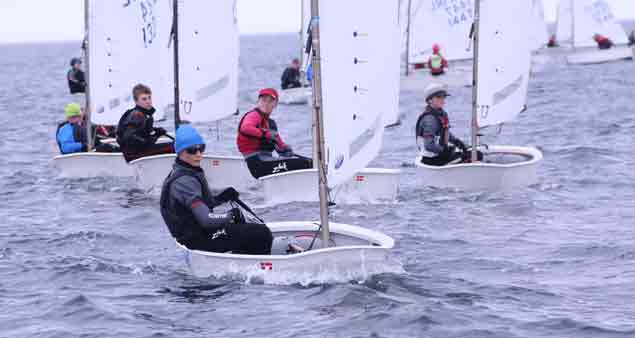 Irish sailing’s future. Optimists in strength at the Ballyholme Championship
Irish sailing’s future. Optimists in strength at the Ballyholme Championship
Some are so special they’re unique. We could devote several articles to the many activities and events of the International Optimist dinghy in Ireland, and likewise the International Topper. Yet we’d still barely be getting to grips with two remarkable sailing class structures, for their rapid throughput of rising junior talent always gives the picture the sense of a rapidly rolling tapestry.
 The International Topper made a significant contribution to the fleet size of 190 boats at Ballyholme.
The International Topper made a significant contribution to the fleet size of 190 boats at Ballyholme.
In a different area of the spectrum, the Irish GP 14 Association shows us what can be done by keen people with an adaptable vintage design, a truly nationwide community spirit, and a determination to get value for money. It’s a spirit which can be international, as we saw when the Worlds were staged at East Down YC on Strangford Lough in 2014. And it’s a spirit which can be deployed in the national interest as we saw in October 2017, when the class enthusiastically provided the fleet needed for the All-Ireland Helmsman’s Championship on Lough Owel at Mullingar.
Maintaining such a spirit needs a succession of keen key people, and we see it in classes of other types, sizes and locales. For instance, the Flying Fifteens in Dun Laoghaire with their can-do spirit are matched by the camaraderie-with-a-sense-of-history of their neighbours the Water Wags, while across Dublin Bay in Howth, the 1898-vintage Howth 17s are in better health than ever, with Ian Malcolm at the heart of a movement to keep this unique example of living history thriving.
 The GP 14s are a fine example of a vintage class which continues to thrive thanks to a very active class association.
The GP 14s are a fine example of a vintage class which continues to thrive thanks to a very active class association.
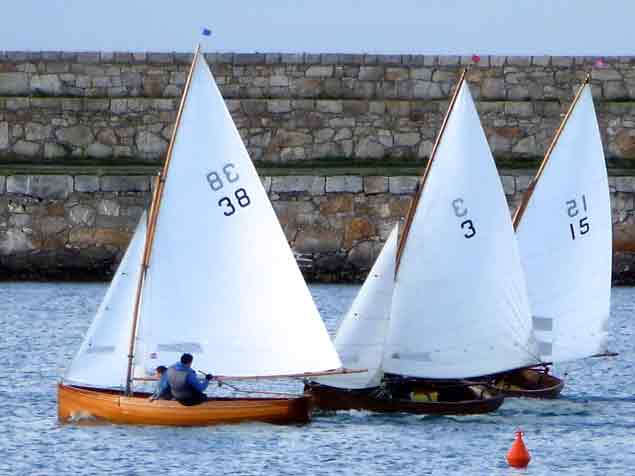 Despite being Centenarians for many years, the Water Wags thrived in 2017 as never before. Photo: W M Nixon
Despite being Centenarians for many years, the Water Wags thrived in 2017 as never before. Photo: W M Nixon
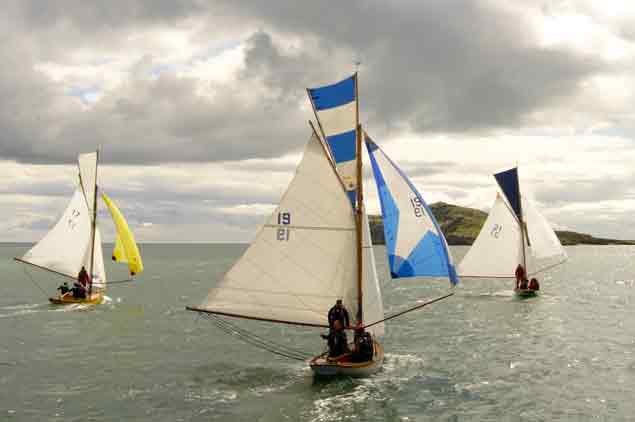 The 1898-vintage Howth 17s were in such good heart that in 2017 they even acquired a new-built boat, Orla (no 21) right. Photo: Neil Murphy
The 1898-vintage Howth 17s were in such good heart that in 2017 they even acquired a new-built boat, Orla (no 21) right. Photo: Neil Murphy
In newer classes, there’s evidence that the SB 20 is developing a fresh and healthy sense of being a special class which can do great things with the right spirit, and this is an attitude from which other more modern boat types can learn, for without people enthusiastically joined in a common purpose, they just become a collection of boats with nowhere to go.
Across country, the traditional boat movement in Galway – reflected in the continuing revival of the Achill Yawls in Clew Bay – provides its own special flavour, with the annual Galway gathering at Kinvara a mighty social event despite poor weather for August 2017’s staging.
 The Galway Hooker An Capall sailing in the waters of the west.
The Galway Hooker An Capall sailing in the waters of the west.
All of this will only impinge slightly on the south and southwest coasts, where boats and sailing are so much an integral part of the social structure that they’re a world to themselves, a self-sustaining universe which is now so large and varied that it’s wellnigh impossible to keep track of the way that our sport is developing.
Time was when you might find one or two boats secreted away on little-known anchorages on Cork Harbour. Most of the fleets would be concentrated at the main centres. But now, absolutely every cove has its little flotilla of boats, and you’d be hard put just to say how many boats are based within this wonderful natural sailing space.
And it’s not just a Cork Harbour phenomenon. Every inlet all round Ireland’s coast now has its local fleet. And every so often, events are staged which give us some notion of the numbers involved. And that also applies to the cruising brigade, whose doing are normally analysed from cruising log competitions during the winter.
For cruisers, 2017 brought an event which gave us some idea of the size and wide-ranging activity of the non-racing brethren. The fact that it wasn’t even staged in Ireland is further evidence of our new confidence and outward-looking approach. The Irish Cruising Club had been planning a rally in Galicia in northwest Spain for some years, the lead organiser being Peter Haden, whose home port is Ballyvaughan on Galway Bay, but he has wide-ranging experience and many contacts among the rias of Galicia.
 Michael Holland’s 70ft ketch Celtic Sprit in the Irish Cruising Club’s July rally to northwest Spain. Photo: Trish Phelan
Michael Holland’s 70ft ketch Celtic Sprit in the Irish Cruising Club’s July rally to northwest Spain. Photo: Trish Phelan
It was expected that if all went well, the rally in July 2017 might attract as many as 30 boats. In the end, they’d to cap numbers at sixty, and many of them had sailed from Ireland across the Bay of Biscay, some from the furthest ports in the north. It went superbly well, and gave tangible evidence of just how much Irish sailing has come on in the past twenty years.
At home on the offshore racing front, the single highlight was the Dun Laoghaire to Dingle Race – won in tough weather by Paul O’Higgins’ JPK 10.80 Rockabill VI – but a significant turnout in the Fastnet Race saw Michael Boyd’s Lisa be best of the Irish, right among the front runners, while the Irish National Sailing School’s J/109 Jedi won Class 3B and the Roger Justice Trophy for the best-placed school bat. Her crew included 17-year-old Lorcan Tighe, who was sailing as an instructor rather than a trainee, and already had the experience of the 2016 Round Ireland Race under his belt at the age of 16.
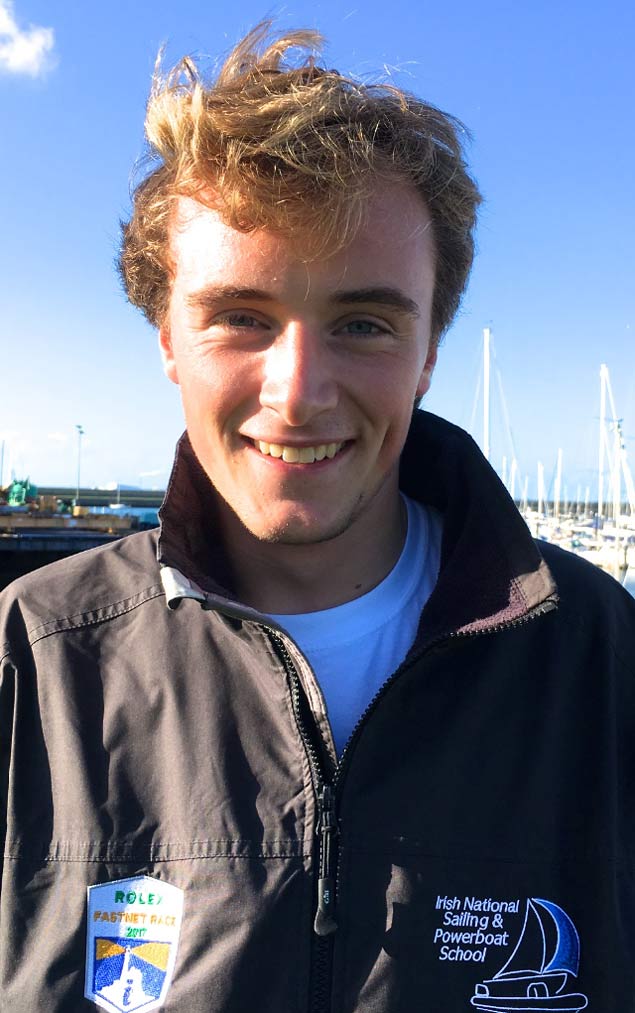 Lorcan Tighe of Dun Laoghaire, an offshore veteran at 17. He was an instructor aboard the Irish National Sailing School’s J/109 Jedi which won two prizes in the Rolex Fastnet Race 2017, and was foredeck hand aboard Lynx in the 2016 Volvo Round Ireland Race.
Lorcan Tighe of Dun Laoghaire, an offshore veteran at 17. He was an instructor aboard the Irish National Sailing School’s J/109 Jedi which won two prizes in the Rolex Fastnet Race 2017, and was foredeck hand aboard Lynx in the 2016 Volvo Round Ireland Race.
But while this high profile international success was important, a key aspect of Irish sailing in 2017 was the growing good health of the Irish Sea Offshore Racing Association, largely thanks to the untiring efforts of Chairman Peter Ryan of Dun Laoghaire, who is the very essence of the spirit of ready voluntarism and quiet persuasion which makes Irish sailing what it is today.
Something which became more clear during 2017 was the readiness of sailors to differentiate between class, regional, national and international championships as being on a different plane from regatta events. This differentiation can be fairly fluid. For instance, some dinghy classes make their racing in the Volvo Dun Laoghaire Regatta their Leinster Championship as well. But generally, there was no mistaking the difference between the serious mood of the ICRA Nationals at Crosshaven as against the Sovereigns Cup at Kinsale, or the huge-fleet Irish Sailing Junior Pathway Nationals at Balyholme in April when compared to the more relaxed Junior Regatta at Howth in August.
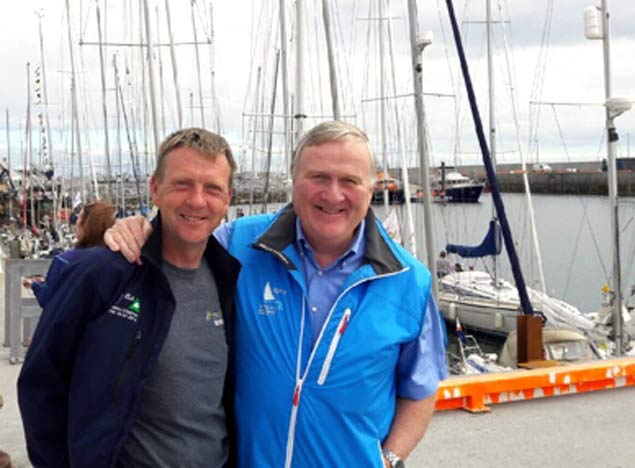 Simon McGibney (Commodore, Irish Cruiser-Racer Association) and Jack Roy, President Irish Sailing, in July at the first-ever WIORA Championship to be staged at Kilronan in the Aran Islands.
Simon McGibney (Commodore, Irish Cruiser-Racer Association) and Jack Roy, President Irish Sailing, in July at the first-ever WIORA Championship to be staged at Kilronan in the Aran Islands.
Of course, some events carved a character so individual as to defy classification, such as Calves Week in August at Schull, or the Half Ton Classics at Kinsale the same month, or the WIORA Championship in the Aran Islands in July. That was something else altogether. Who would have thought, even ten years ago, that the very first sailing event at the new pontoons in Kilronan in our quintessentially western Aran Islands would attract a crack fleet of 44 boats, though local pundits did successfully predict that Liam Burke with Tribal would be the winner.
These highly-populated and fun-oriented events contrast markedly with the world of the international single-handers, who may start from much-visited event villages at their departure ports, but they’re utterly on their own out at sea. Yet they keep at it, and Tom Dolan of Meath recorded Ireland’s best-ever place in the Mini-Transat with a sixth overall in a class of 54 boats in 2017’s staging of the little boats’ big crossing.
 Tom Dolan’s Pogo 3 IRL 910 in flying form.
Tom Dolan’s Pogo 3 IRL 910 in flying form.
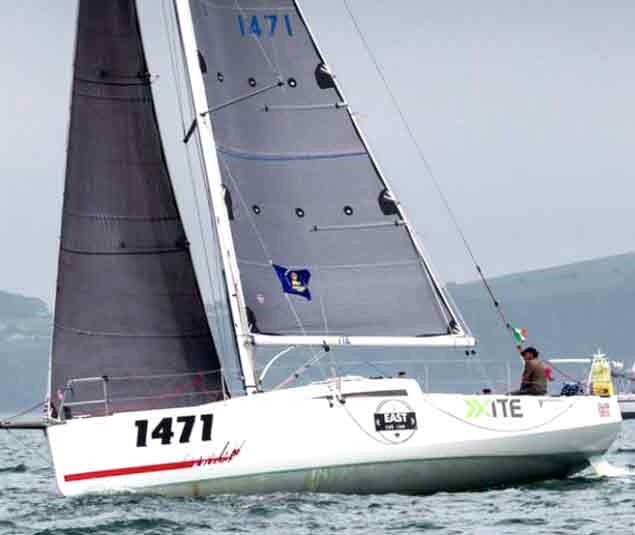 Conor Fogerty’s Sunfast 3600 Bam! at the start of the east-west Single-Handed Transatlantic Race, which was to experience a severe storm at mid-Atlantic, but the Irish boat went on to win the Gypsy Moth Trophy
Conor Fogerty’s Sunfast 3600 Bam! at the start of the east-west Single-Handed Transatlantic Race, which was to experience a severe storm at mid-Atlantic, but the Irish boat went on to win the Gypsy Moth Trophy
That was in November. But it was back at the end of May that the Single-Handed Transatlantic Race from Plymouth to Newport, Rhode Island got under way, with Conor Fogerty of Howth sailing for Ireland in his Sunfast 3600 Bam. The Atlantic in June was in a foul mood, and several boats were rescued, but Bam had gone so well she was to the westward of the very worst of the storm, and raced on the win the real prize, the Gypsy Moth Trophy.
The fact that he had done so had settled quietly into our memories of the early season until one morning at the end of November, when the bare hull of one of the abandoned Transatlantic single-handers, Michele Zambelli’s Illumina 12, was found upside down on a Kerry beach. It was a chilling relic of the mid-Atlantic super-storm of June, an eloquent reminder that Bam’s great victory was won against ferocious odds.
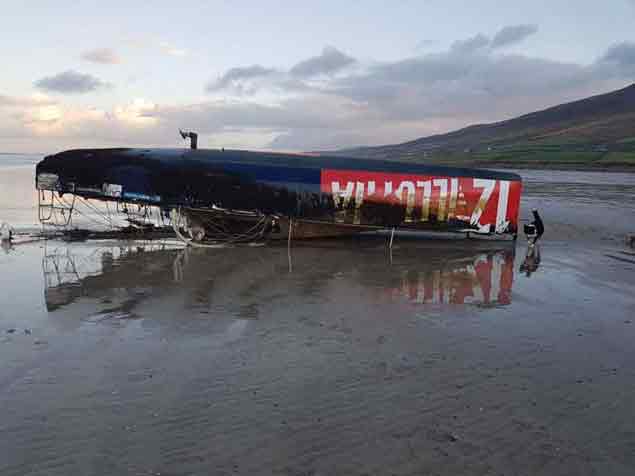 Chilling reminder of an Atlantic storm, The remains of the Italian Illuminia 12 on a Kerry beach a month ago.
Chilling reminder of an Atlantic storm, The remains of the Italian Illuminia 12 on a Kerry beach a month ago.
In the post-Olympic year, the Olympic contenders were going through a quiet phase, but they’ll getting up to speed again early in 2018, though Silver Medallist Annalise Murphy is on a different tack at the moment. She’s a crew-member on Turn the Tide on Plastic in the Volvo Ocean Race, but her Olympic preliminaries in 2018 have been factored in.
Meanwhile in 2017, when summer did finally come to Ireland in July, we had the event and the organization in place to do it full justice. The Volvo Dun Laoghaire Regatta 2017, from July 6th to 9th also celebrated the Bicentenary of Kingstown Harbour, and was simply the best sailing event in Ireland in Ireland during the year that is now leaving us.
 Celebrating 200 years. A perfect summer’s afternoon as the restored Dublin Bay Perwinkle and the restored 1897 cutter Myfanwy race for the Dun Laoghaire entrance and the in-harbour finish. Photo: Afloat.ie/David O’Brien
Celebrating 200 years. A perfect summer’s afternoon as the restored Dublin Bay Perwinkle and the restored 1897 cutter Myfanwy race for the Dun Laoghaire entrance and the in-harbour finish. Photo: Afloat.ie/David O’Brien
The experience and the organisation were in place under Chairman Tim Goodbody to do the occasion justice, the entry numbers were up with an impressive Classics and Traditional section to honour the Bicentenary. All that was needed was the weather, and the Irish climate obliged. There were sailing breezes every day, sunshine every day, and with it all a comfortably warm ambient temperature that kept up late into the night to facilitate an indoors/outdoors lifestyle that had Dun Laoghaire’s classically elegant waterfront heaving with celebrating people having the time of their lives.
That it seemed so good may have something to do with the fact that many 2017 sailing events in Ireland were unlucky with their weather. It was just the way things panned out. But Dun Laoghaire with its entertaining in-harbour finishes was pure regatta with prizes galore – so many, in fact, that we need remember only one to represent them all.
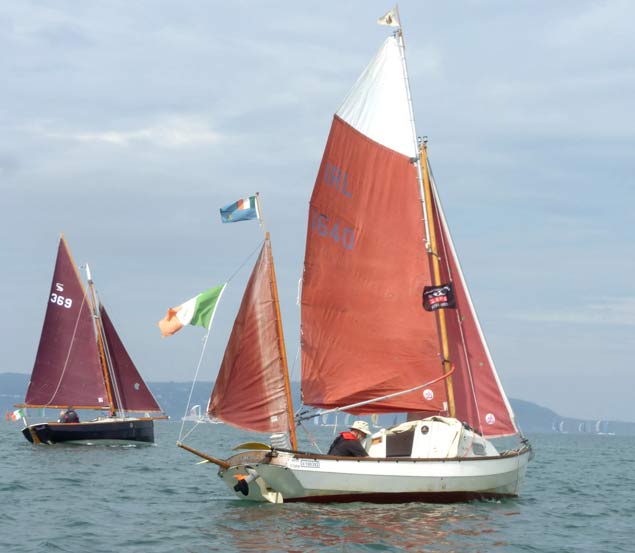 All were welcome to race in the Classics & Traditional section at the Kingstown Bicentenary. This is Jack O’Keeffe’s much-travelled Drascombe from Cork. Photo: W M Nixon
All were welcome to race in the Classics & Traditional section at the Kingstown Bicentenary. This is Jack O’Keeffe’s much-travelled Drascombe from Cork. Photo: W M Nixon
But it was the special one. The Kingstown 200 cup complete with a traditional purse of 100 guineas. And it went to a very special visitor, the 1897-built 37ft Myfanwy from Wales, originally designed by the great Alexander Richardson of Liverpool (he designed John Jameson’s all-conquering Irex), and restored by her owner-skipper Rob Mason of Milford Haven.
With her sweeping sheer and classic jackyard topsail-setting rig, Myfanwy was arguably the best-looking boat in the regatta. And when I was chatting with her convivial crew after the last race, they were in great form – they downed their pints of Guinness, and asserted that they’d just enjoyed the best five days of sailing in their lives. And that was before they were told that they’d won the Kingstown Cup, purse and all……
 Purest classics. Hal Sisk’s Peggy Bawn (1894, left) and Rob Mason’s 1897 Myfanwy in Dun Laoghaire. Peggy Bawn was fulfilling the classic spirit so completely that she was setting a suit of unused cotton sails at least sixty years old. Photo: W M Nixon
Purest classics. Hal Sisk’s Peggy Bawn (1894, left) and Rob Mason’s 1897 Myfanwy in Dun Laoghaire. Peggy Bawn was fulfilling the classic spirit so completely that she was setting a suit of unused cotton sails at least sixty years old. Photo: W M Nixon
Until a couple of days ago, it was planned to end this last blog of 2017 on that friendly note. For we can all learn much from the success of the Volvo Dun Laoghaire Regatta 2017 and its Kingstown Harbour Bicentenary. It was the perfect combination of good but not too serious racing afloat, and brilliantly done fun times ashore.
But then with the end of 2017 in sight, along comes the Rolex Sydney-Hobart Race 2017, extremely serious stuff. After various kerfuffles, Jim Cooney, whose people hail from Ballivor in County Meath, has taken line honours with the 100ft LDV Comanche, while Gordon Maguire of Howth has mastered the TP 52 Ichi Ban (Matt Allen) into a very hard-fought overall win. Words fail us. But then we recall that after Michael Boyd won the 1996 Round Ireland with the J/35 Big Ears, the incomparable Meath Chronicle ran the splendid headline: “Lobinstown Man Wins Round Ireland Yacht Race”. We live in hope of a similar headline: “Ballivor Man Leads Top Australian Yacht Race.”
And a happy and prosperous New Year to you too.

































































